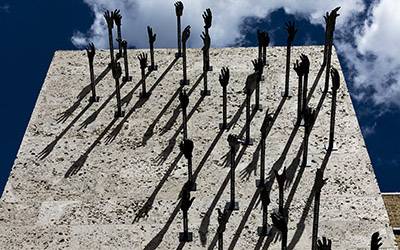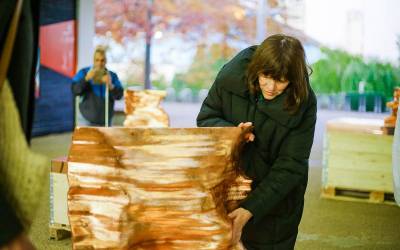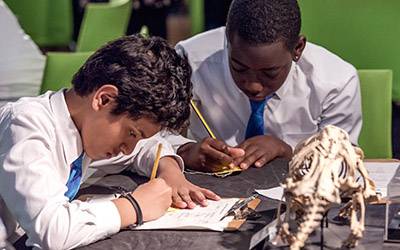At UCL, we value collaboration, partnership and dialogue with our local community.
Our Public Engagement Unit, within the UCL Culture team, offers our students an education that helps them to become thoughtful, resilient and engaged citizens.
UCL Culture connects the university’s world-class researchers and collections with artists, performers and the public. They are home to the Grant Museum of Zoology, Octagon Gallery, Pathology Museum, Petrie Museum of Egyptian Archaeology and UCL Art Museum, as well as Jeremy Bentham’s famous auto-icon, the Bloomsbury Theatre and Public Art.
Through our continuing outreach work, we will ensure that a UCL education is open to all those who have the talent to study here, irrespective of background.
Simon Cane, Executive Director, UCL Culture
Case study: Public art at UCL
At the opening of the Student Centre in February 2019, UCL unveiled a new permanent sculpture by Turner Prize-winning artist Rachel Whiteread. Untitled (Slade Pinboard) is a cast of an historic noticeboard in the UCL Slade School of Fine Art. The piece directly connects the new building with the history and heritage of the Slade. Whiteread studied Sculpture at the Slade and was the first woman to be awarded the Turner Prize in 1993. Untitled is a significant addition to the university’s collection of work by female artists.
The Student Centre is also home to HERE NOT HERE, a new digital installation which livestreams UCL admissions data and simultaneously displays the countries that are represented and not represented at the university. This installation has been created by Jon Thomson, Professor of Fine Art at the UCL Slade School of Fine Art, and Alison Craighead, artist and lecturer at Goldsmiths University, known collectively as the collaborative duo Thomson & Craighead. Together they make artworks that looks at how our perception of the world is changing in the Information Age.
Another Slade alumna, Sarah Fortais produced a bespoke installation of more than 60 hands individually cast in bronze and aluminium that reach out into space above the Wilkins Terrace. Donor Wall is a striking celebration of the individuals and organisations that support UCL’s students and make our cutting-edge research possible.
Image: Sarah Fortais' Donor Wall - Photo by Hydar Dewachi
Links: UCL Culture/UCL Slade School of Fine Art/UCL Student Centre
Case study: Growing Community-University Partnerships
The UCL Public Engagement Unit has funded knowledge exchange activities with communities in east London as part of UCL East – UCL’s future campus in Stratford, east London.
The Trellis programme of knowledge exchange has brought together UCL scientists and engineers with artists from or working in east London, to create four new installations on Queen Elizabeth Olympic Park in October 2019.
Artists and researchers worked together to create a free exhibition of sculptures, drawings and films, inspired by the history of the Lea Valley and the future of UCL East.
Located around the future site of the new campus, a new hub of discovery and co-creation, these installations offered an insight into the world of research, and a study in the creative process.
The aim of the Trellis programme is to discover how knowledge exchange activity between universities and communities can maximise impact for both parties and how partnerships can best be supported to flourish around our future campus at UCL East.
This long-term programme, supported by the Engineering and Physical Sciences Research Council (EPSRC), will continue throughout 2020 and will create opportunities to examine the shared ideas that emerge when an artist and a researcher are given space to develop their mutual interests.
Image: A participant from ‘Beyond Sight Within Grasp (Red, Yellow and Blue)’ who worked with Beyond Sight Loss, artist David Rickard and Professor Tony Kenyon on the art work.
Credit: Ondre Roach
Links: UCL Culture/Trellis Programme
Case study: Building robots inspired by nature
UCL runs a free project for state schools in east London that gives young people the chance to learn about robotics, 3D printing and animal movement through a series of workshops delivered by UCL students and academics from four departments.
Bio-robotics and Animal Movement explores the links between robots, computer programming and animal movement and is inspired by today’s scientists and engineers who are drawing inspiration from the animal kingdom to create the next generation of robots.
The project runs over a term and includes a training session for teachers, an Animal Locomotion workshop at the Grant Museum of Zoology, a student-led tour of UCL, and a loan of a bio-inspired robotics kit with technical support from UCL students.
The project was recognised by the Ogden Trust, who have provided additional support to allow the team to extend their work with the Petchey Academy in Hackney and develop a robot inspired by the Grant Museum’s kangaroo skeleton.
Past pupils have showcased their work at a special science festival for the public, where they learnt more about STEM research directly from the UCL academics and students.
Links: UCL Culture/Bio-robotics/The Ogden Trust
Further information
 Close
Close




